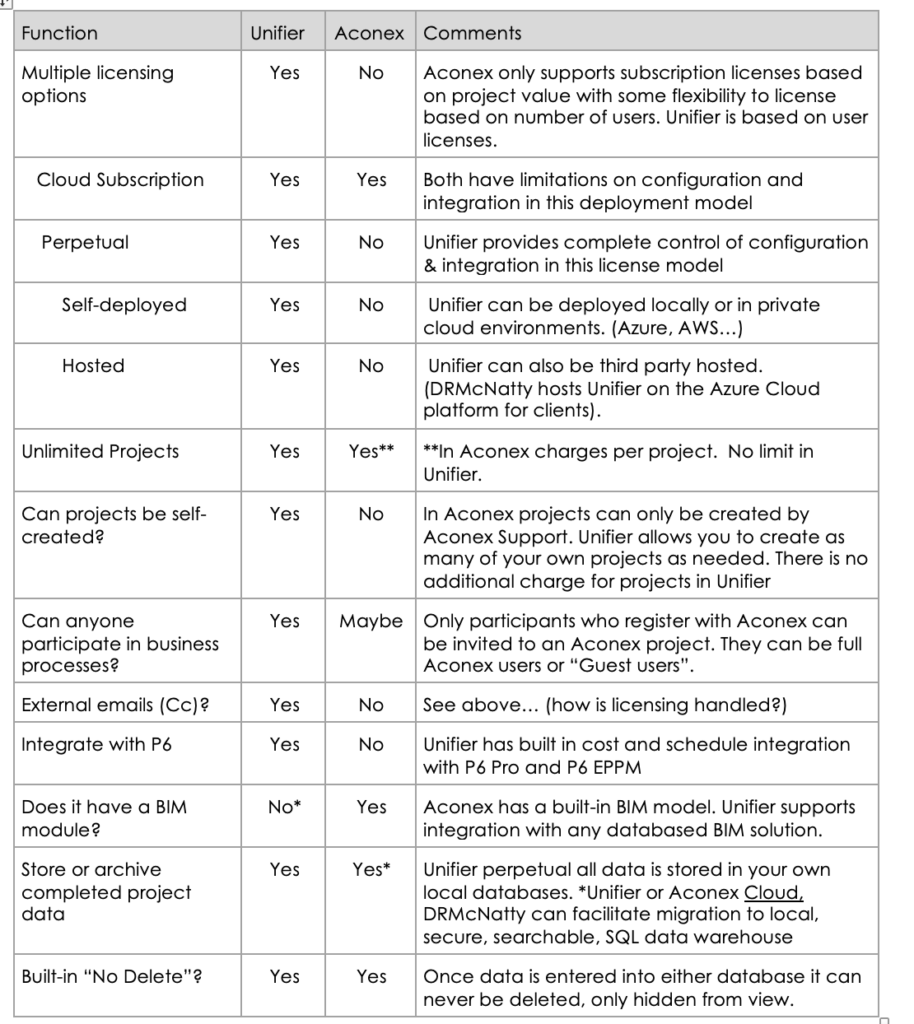How your organization deals with projects will drive your decision.
While Oracle can offer two solutions for the same problem, once you have a clear understanding of how each works it should be clear which is best in your environment.
UNIFIER was developed to meet the “forever need” of project-based organizations. As an example, a Transportation Agency will have many large projects or programs, and perhaps hundreds of small, ongoing Capital and Maintenance projects that span many years. As an example, a Capital project may take 3 to 5 years to go through the design and construction process and then have a 20 to 50-year useful life requiring ongoing maintenance and upgrades. All of the information related to the facility needs to be organized, secured, and accessible for multiple generations of team members.

As your organization’s project management processes mature the system needs to be flexible enough to support not only changes in business processes but also changes in the underlying technology. While many project-based organizations have dedicated people and business processes in-house they often bring in specialized teams to help manage projects and groups of projects (programs, portfolios…) that also must integrate with the in-house teams. By having an in-house standard already in place to support both internal and external teams, the organization can be assured that all relevant project information is properly captured, categorized, secured, stored, and available for any team member that may need it. In the past, many organizations have brought in large consulting firms with their internal tools resulting in a disjointed data environment that is not uniform across all projects. When Unifier is deployed you are deploying a tool that will become the foundation of how your Program/Portfolio/Project based organization and your supporting internal and external teams function for many years.
ACONEX was developed to provide a secure, shared environment where all companies working on the project can directly interact with one another during the life of a single project in an environment where ALL project-related interactions are captured, secured, and stored. While Aconex does support multiple projects its greatest benefit is on a single high-risk project.
Aconex example 1: A football team is embarking on a $1.4B project to build a new stadium. The team is not a project-based organization. They have few if any internal business processes or team members in place to manage new complex capital projects. The team has received some external funding for their project but they are responsible for all cost overruns beyond the $1.4B budget. Aconex would be a very good environment for the team to protect their interests by deploying a project-based environment to support (capture, categorize, secure, and store) all communications between everyone involved during the life of the stadium project.
Aconex example 2: A large public agency may have the occasional, very large, and complex project that they decide to contract for in a manner that puts most of the risk on a third party (Design/Build). It is common for several companies to join forces in a joint venture effort to build the project. Rather than using one of the team members’ in-house tools (very common), it would be in the owner’s best interest to deploy Aconex just for this special project/project team. The owner’s team can then participate in either the Aconex environment or develop special business processes or integration points where final or approved information can be captured from Aconex and stored in the owner’s everyday system. DRMcNatty provides integration utilities that can help Unifier and Aconex “talk” to each other and share data.
The “un-talked about” benefit to the owner for an Aconex environment is that should the project end up with claims situations, all of the internal interactions for each project participant should be discoverable during legal proceedings.
Additionally, both products have a “never delete” rule that preserves all data.
LICENSING
This can be another factor in your decision as Unifier supports both Subscription (SaaS) and Perpetual licensing while Aconex only supports Subscriptions. The choice of subscription vs perpetual license is based on some key considerations. On large projects Aconex is usually priced based on “project value” rather than number of users.
Subscription vs Perpetual: What’s the difference?
In a subscription software model, the customer accesses software owned by the vendor via an ongoing agreement and pays regular amounts to access the software. The vendor retains ownership of the software. Also with subscription software, there will be some elements built into the software which you can configure to your requirements. By and large, however, a subscription product is provided as an ‘off-the-shelf’ solution. This means that it may not be possible to make changes to the software specific to your own business and reduces the benefit of customized configuration and integration.
In a perpetual license software model, the client buys the software outright. This means that they own the software for the lifetime of the product, albeit sometimes retaining an agreement with the vendor regarding annual maintenance and upgrades that are usually needed on an ongoing basis. In this model, you can self-deploy or have a professional third-party team host it for you. In this model, you have complete control over configuration and integration. DRMcNatty provides hosting and integration support. The Pros and Cons of Subscription and Perpetual Licenses – additional information: SUBSCRIPTION VS. PERPETUAL LICENSE: WHICH IS RIGHT FOR YOU – DRMcNatty & Associates
At DRMcNatty our customer service record sets us apart, and we offer significant benefits from our hosting solutions. Get in touch today for a conversation about how our expertise can help you make the correct software choice.









